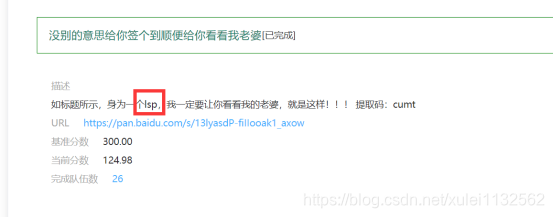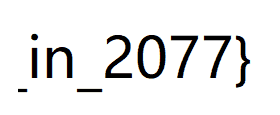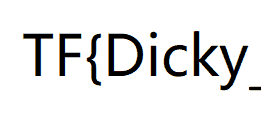Misc has no other meaning to sign you in and show you my wife
Lsb steganography

From the title of lsp to lsb steganography, use
Open, the three low bits are 0,

Then remove the spaces between them, that's it.
Big bird turns round turns round turns round turns round
uses the same software,

Frame by frame analysis


Put it together and come out
Simple rsa
from Crypto.Util.number import *
import gmpy2
k = 33168381182273613039378043939021834598473369704339979031406271655410089954946280020962013567831560156371101600701016104005421325248601464958972907319520487
c = 15648371218931722790904370162434678887479860668661143723578014419431384242698608484519131092011871609478799077215927112238954528656254346684710581567304227780228595294264728729958171950314042749100472064919234676544341981418897908716041285489451559413615567610248062182987859379618660273180094632711606707044369369521705956617241028487496003699514741969755999188620908457673804851050978409605236834130689819372028797174206307452231481436775711682625666741103384019125790777595493607264935529404041668987520925766499991295444934206081920983461246565313127213548970084044528257990347653612337100743309603015391586841499
e = 4097
phi = k-1
d=gmpy2.invert(e,phi)
flag = pow(c,d,k)
print(long_to_bytes(flag))
The public key of Rsa algorithm e is known, c (ciphertext) is known, and a tuple is given. The first element is the public key, and the second is the private key. K is n, so d is calculated, pow(c , D, k) to find the plaintext.
Reference website https://blog.cryptohack.org/cryptoctf2020
网上的思路:
The challenge encrypts the flag with a modulus
N=(p∗q∗r)∗(p+q+r)
and gives the output n=pqr, k=p+q+r. To totally break the cryptosystem, we would want to find the totient of the modulus
ϕ(N)=(p−1)(q−1)(r−1)(p+q+r−1)
but we can simplify this when the encrypted message m is small enough. If we have m<k, we can instead find ϕ(k)=k−1, and find e−1modϕ(k), and solve!
Observe that for any n,l, as long as l|n, any equivalence a≡b(modn) also holds mod l: a≡b(modl) (but note that the other way around does not necessarily hold). To fully see this, we can write
a⇔a⇒a≡b(modn)=b+kn=b+ktl(since l|n, so n=tl)≡b(modl)
So, since k|n, we can solve m≡m1+ϕ(k)(modk) as if it was a single-prime RSA problem. And because m<k, the residue [m]k (the rest when dividing m by k) is exactly equal to m.

Scribbled password
analysis logic, it can be seen that the replacement password, one letter corresponds to another letter, and only appears once.
I wanted to use the script and analyzed it through word frequency. However, after doing it for a long time, I tried I searched the online cracked website, and found that it really took a detour

Crack the connection to the website https://quipqiup.com/

After
the question of ez_rsa was asked , I immediately searched it on Google, and I found the original question, and I got a lot of blood
from Crypto.Util.number import *
from gmpy2 import invert
n=17986052241518124152579698727005505088573670763293762110375836247355612011054569717338676781772224186355540833136105641118789391002684013237464006860953174190278718294774874590936823847040556879723368745745863499521381501281961534965719063185861101706333863256855553691578381034302217163536137697146370869852180388385732050177505306982196493799420954022912860262710497234529008765582379823928557307038782793649826879316617865012433973899266322533955187594070215597700782682186705964842947435512183808651329554499897644733096933800570431036589775974437965028894251544530715336418443795864241340792616415926241778326529055663
e=65537
enc=17505679398266502116464734134128725340247050682772207798718112582701162398326982870035320307354098156145675458669731605067821790146061040637109327455205893324813052120216078570610930872674755246099365674625431655007219684642963335426955196473587347290657014023186920750946928312239116919090008342804123453311441848155223191179999664929660663345568499980778425899869956228245802722031728956228667784902213280684273577858909961747898300981963006329584725303446719192681170020458749808054637224882633325702468591074293728614333360418157985394943356536309321590140334348949095024011542798810065149061943391776967748248277703228
beta=11864389277042761216996641604675717452843530574016671576684180662096506094587545173005905433938758559675517932481818900399893444422743930613073261450555599
tip = (n-1)//(2*beta)
xy1=tip//beta
def attack(xy1):
while True:
try:
xy1=xy1-2
d=invert(e,2*xy1*pow(beta,2))
c=pow(3,e,n)
if pow(c,d,n)==3:
return d
else:
continue
except:
continue
d=attack(xy1)
print long_to_bytes(pow(enc,d,n))
Then for the problem of obtaining x + y, since beta is 512 bits and the number of n bits is 2068, then the average number of p bits is 1034, then the number of x bits is probably 1034 – 1 – 512 = 521, x + The difference between y and beta is about 10 digits, which is completely violent. n = p * q = 4xybeta ^ 2 + 2(x+y )beta + 1
It is natural to get tip = (n-1)/ /beta
Then we give the tip modulus beta, we can get (x+y)%beta, if we can get x + y, then obviously we can also get x * y, and then solve an equation to get x and y , Then you can get p and q, and then decrypt rsa to get the flag, basically run with py2, simply modify the corresponding parameters, you need to use the
Try
Except statement, because the blasting is unsuccessful, but you need to continue
(it shows that it cannot be reversed Yuan) The
initial error is probably because the error statement was not used to write
Since my py2 environment has forgotten where to go, so the script I wrote and the exp run by my teammates
came out and checked in.
Reference website https://www.cnblogs.com/crybaby/p/12940219.html
Reference script
Write exp
from Crypto.Cipher import AES
def xor(p1, p2):
tmp = ''
for i in range(len(p2)):
tmp += chr(ord(p1[i]) ^ ord(p2[i]))
return tmp
key = "\t\xe6\x85]):\x1b\x86\xffD\xf1\x89H\xb1\x9b\xac"
cipherText1 = "ed64978b91ef5b62561a44c8f529b91f".decode("hex")
cipherText = "fd6dd5e0f9ab258b2bc9c813177e3ad677116d2f08c69517d0e7796c1f5e06ba95c3de5a139bb687bf3e779a0730e47c".decode("hex")
plainText = "CBC_Cr4cked_succ"
fakeIV = "aaaaaaaaaaaaaaaa"
fakeIVAes = AES.new(key, AES.MODE_CBC, fakeIV)
fakePlainText = fakeIVAes.decrypt(cipherText1)
enc_msg = xor(fakePlainText, fakeIV)
iv = xor(enc_msg, plainText)
print len(iv)
print "iv is : " + iv
aes = AES.new(key, AES.MODE_CBC, iv)
flag = aes.decrypt(cipherText)
print flag
This cryptographic algorithm, model is the model learned in the cryptography class. I believe that those who have learned the cryptography will be able to use it. Since I don’t have a py2 environment, I still run it by my teammate
Made the first level and then the second level
flag = "bxsyyds{
xxxxxxx}
assert flag.startswith("bxsyyds{")
assert flag.endswith("}")
assert len(flag)==16
def lfsr(R,mask):
output = (R << 1) & 0xfffffff
i=(R&mask)&0xfffffff
lastbit=0
while i!=0:
lastbit^=(i&1)
i=i>>1
output^=lastbit
return (output,lastbit)
R=int(flag[8:-1],16)
mask=0b1001000000100000001000100101
f=open("result","w")
for i in range(100):
tmp=0
for j in range(8):
(R,out)=lfsr(R,mask)
tmp=(tmp << 1)^out
f.write(chr(tmp))
f.close()
After doing cryptographic experiments, it is easy to find that it is an lsfr stream cipher. You need to find the first 7*4=28 binary streams of the binary mode corresponding to the result.
Because of carelessness at the beginning, the conversion of hexadecimal to binary was wrong! ! !
Quite detours
Then after a short period of thinking about life, check whether the binary system is right or not, it turned out to be wrong.
re1
Reference
https://driverxdw.github.io/2019/04/24/2019%E8%A5%BF%E6%B9%96%E8%AE%BA%E5%89%91CTF-%E4%BA%8C/
0x3A=3*16+10=58
BASE58 encoding
I forgot to press Enter when running the above...
>>> s='34avux4BwXYJzh1nHK1oG5xTKeBSCERZs4xC'
>>> t='123456789ABCDEFGHJKLMNPQRSTUVWXYZabcdefghijkmnopqrstuvwxyz'
>>> flag=0
>>> for i in range(len(s)):
... flag=flag*58+t.index(s[i])
... flag
File "<stdin>", line 3
flag
^
SyntaxError: invalid syntax
>>> flag
0
>>> flag
0
>>> for i in range(len(s)):
... flag=flag*58+t.index(s[i])
...
>>> flag
108200298718158997245509125691632101258313020496600351308152445
>>> hex(flag)
'0x43554d544354467b3841736535425f31735f456135797e7e7e7d'
>>> from binascii import *
>>> a2b_hex('43554d544354467b3841736535425f31735f456135797e7e7e7d')
b'CUMTCTF{8Ase5B_1s_Ea5y~~~}'